LisbonLisboaPortugal.com
The best independent guide to Lisbon
LisbonLisboaPortugal.com
The best independent guide to Lisbon
Elevador de Santa Justa, Lisbon – a guide for 2025
The Elevador de Santa Justa is one of the truly unique tourist attractions of Lisbon. This 19th-century industrial-era lift (elevator) transports passengers up the 45m from the Baixa district up to the Largo do Carmo.
The Elevador de Santa Justa dates from an age when wrought iron was not just a construction material but also an elegant art form. The exterior structure is decorated with glorious neo-Gothic arches and geometric patterns, while inside, two polished wood carriages transport passengers in style.
Historically, the Elevador de Santa Justa was an invaluable part of Lisbon’s public transport network, but today it is primarily a tourist attraction. This sadly means there will always be a long queue to ride to the top, and the fare is comparatively expensive at €5.30.
It is possible to walk to the top of the Elevador de Santa Justa via the surrounding streets, but it will involve climbing up the steep hill - the best walking routes are shown later in this guide.
At the top of the Elevador de Santa is one of the finest viewpoints of central Lisbon, with panoramic views over the Baixa district. In the evening, this viewpoint transforms into one of the most romantic locations in Lisbon and is often filled with young lovers.
To the rear of the lift, a walkway leads around the ruins of the Igreja do Carmo church to the Largo do Carmo, a traditional and charming plaza. There is a lot for you to discover in this area, including the Museu Arqueológico, the Igreja do Carmo, the Museu da GNR and the trendy Carmo rooftop bar.
This article will help you get the most from your visit to the Elevador de Santa and includes how to ride it for the lowest price, how to walk to the top, and details of sights in the surrounding area.
Related articles: The Baixa district – Lisbon in 2 days
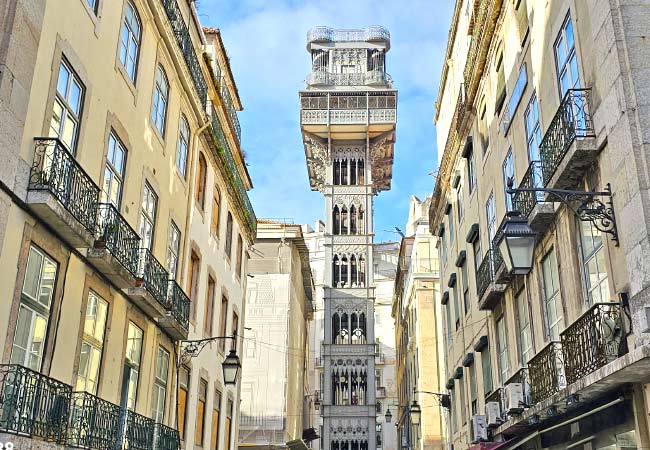
The lift/elevator ascends seven storeys up one of the steepest hills in Lisbon
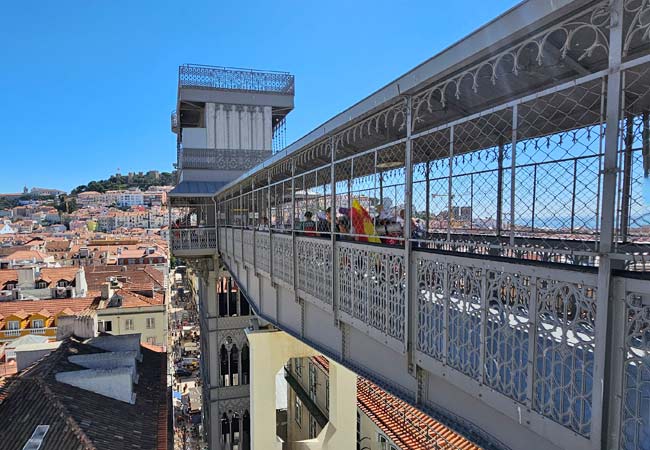
The amazing view from the top of the tower with the castle in the distance
Elevador de Santa Justa tourist information
The Elevador de Santa Justa connects the Rua de Santa Justa in the Baixa district (GPS: 38.71212, -9.13940) with the Largo do Carmo in the Bairro Alto district (GPS: 38.71203, -9.14012).
The lift is operated by Carris, the public transport company of Lisbon, and is referred to as route 54E. A return ride costs €5.30, and tickets can be purchased from the ticket office at the base of the lift.
The Elevador de Santa Justa is open every day between 7am and 11pm (summer) or 7.30am and 8.38pm (winter). There are five departures every hour between 9am and 7pm, with this number increasing during the peak season. The latest timetable can be seen on the Carris website: www.carris.pt/
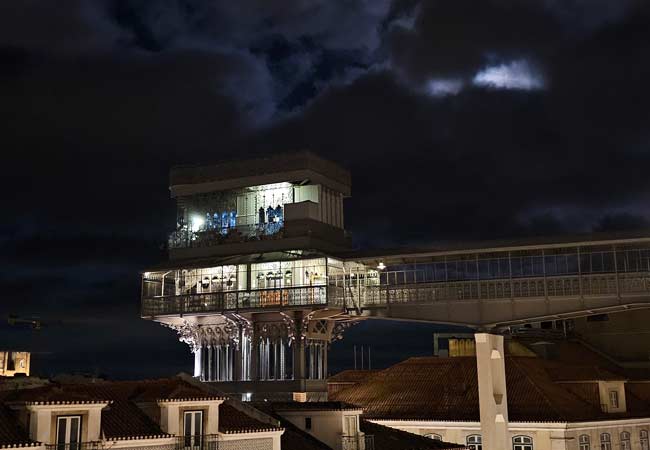
The top of the lift is a romantic location at night
A quick history of the Elevador de Santa Justa
The Elevador de Santa Justa was constructed as part of a city-wide project to help Lisbon’s residents navigate the many steep hills of the city. Its construction was in conjunction with three funiculars (Gloria, Bica and Lavra), with the Santa Justa being the only public transport lift.
Insight: Interestingly, a similar project was undertaken almost 100 years later with the construction of the two Elevador Castelo lifts and the soon-to-be-opened Graca funicular.
1896 – Lisbon Council proposed the construction of a vertical lift
1900 – Construction started under the direction of Raoul Mesnier du Ponsard
31st August 1901 – The walkway and tower were inaugurated by King Carlos I
Late 1901 – The steam engine used to power the lift is installed at the top of the tower
10th July 1902 – The lift was inaugurated and opened to the public
1907 - An electric engine replaced the steam engine
2006 – Major restoration project and modern safety features added
Historic insight: The viewing platform at the top of the structure was the original location of the steam engine that powered the lift. The steam engine did not raise the lift directly but pumped water into two tanks held below the two cabins, which were connected by a steel cable. As the pumped water increased the weight of the upper cabin, it raised the lower cabin, with the speed being controlled by mechanical brakes. This steam engine was replaced by an electric engine in 1907.
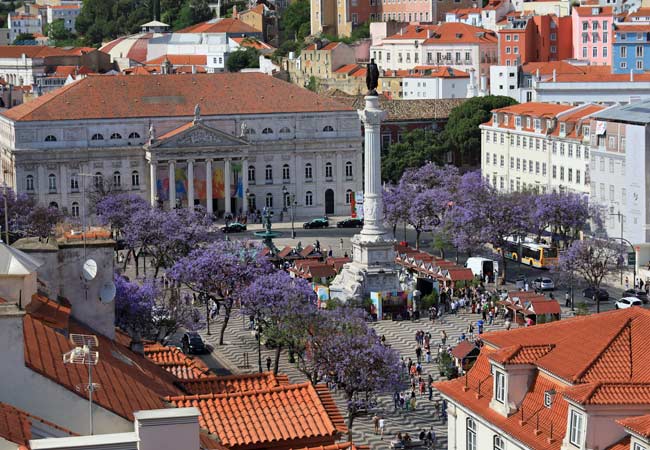
Rossio Plaza, as seen from the top of the Elevador de Santa Justa
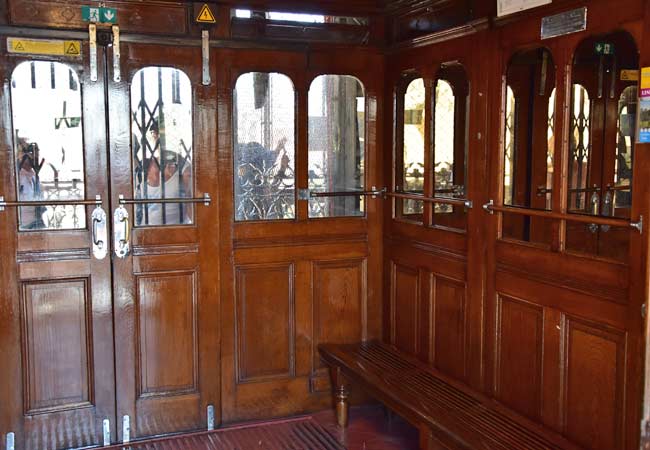
The polished wood interior of the lift
Is it worth riding the Elevador de Santa Justa?
The Elevador de Santa Justa is one of the most popular tourist attractions of central Lisbon; however the limited capacity of the cabins (25 people) means it is always busy. Also, riding the lift at peak times is not a great experience, as the maximum number of passengers are jammed into the cabin.
If you want to ride the lift for the tourist-experience, then it is best to ride it early in the day (before 9:30 am) or late in the day (30 minutes after sunset until closing time). If your only chance to ride the lift is during peak times, it is better to ride it going down, where it will always be much quieter than going up.
If you want to ride the Elevador de Santa Justa simply to get to the top of the hill and the Largo do Carmo, it is often much quicker to walk than to queue and ride the lift. The uphill routes via the Baixa-Chiado metro station contain escalators, and removes significant sections of the hill (details of these walking routes later on).
If you wish to ride the Elevador de Santa Justa for the view, it is better to walk up the hill and enter the lift from the upper walkway, which is free.
Insight: Three years ago, there was a viewpoint at the very top of the tower, but during the ongoing reconstruction work, it has been closed for safety. At present, it is free to walk around the level the lift exits onto, and this provides almost as good a view.
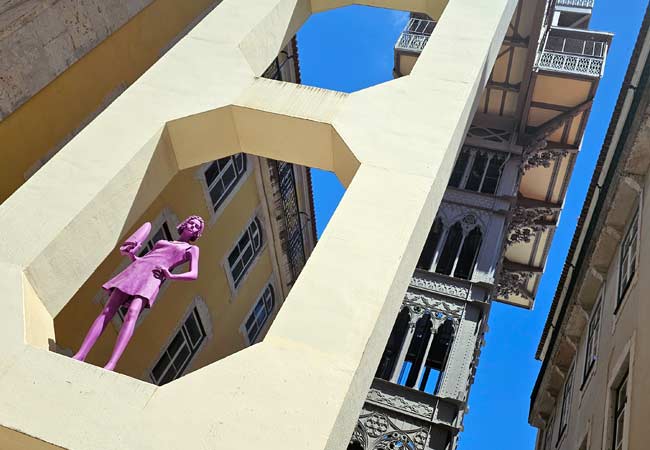
How about a small group tour?
One of the best ways to discover Lisbon and meet fellow travellers is to join a guided tour. We have worked with Getyourguide.com for the last six years, and some of their best tours of Lisbon include:
Cheaper ways to ride the Elevador de Santa Justa
The Elevador de Santa Justa is technically part of the public transport network of Lisbon, and is managed by Carris, the public transport company. This means that a ride on the lift is included in the 24-hour public transport ticket, or can be paid with a ‘Zapping’ fare, both options make it much cheaper than the €5.30 fare charged at the ticket office.
The 24-hour public transport ticket includes all of Lisbon’s trams, funiculars, metro and buses and costs €7.00. The ‘Zapping’ fare involves loading credit (between €3-40 Euro) onto a Navegante card (€0.50 for the initial purchase) and reduces the Elevador de Santa Justa fare to just €1.70. Annoyingly, both the 24-hour ticket and the zapping ticket can only be purchased from a ticket machine in a metro station. The nearest metro station to the Elevador de Santa Justa Baixa-Chiado or Rossio.
The 24-hour ticket provides exceptional value during a day of sightseeing in Lisbon, as along the metro, buses and trams, it also includes the funiculars, and historic trams. This includes the three funiculars Glória, Bica and Lavra, the Elevador de Santa Justa and the charming E28 tram.
Insider tip: The Ascensor da Lavra, is virtually unknown to tourists and provides the most peaceful and authentic funicular ride in Lisbon.
Related articles: E28 tram - Ascensor da Lavra
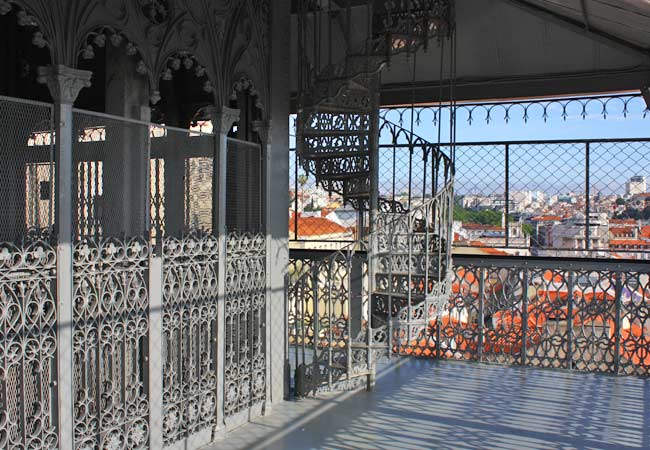
The spiral stairs up to the upper level and the viewpoint
Walking up the Elevador de Santa Justa route
The long queues at the base of the Elevador de Santa Justa should not deter you from visiting the Largo do Carmo and the viewpoint at the top of the lift.
The shortest route to the top is via the staircase behind the shops of the Rua do Carmo. The entrance is hidden along an alley (GPS 38.7114, -9.13968) just to the left/south of the Footlocker shop. This may be the shortest route, but it involves a lot of stairs and is a dingy way.
A nicer walking route is to follow the Rua do Carmo up the hill, then turn right at the Armazéns do Chiado shopping centre and then turn right again along the Calçada do Sacramento. The Calçada do Sacramento is another steep hill.
If you prefer to avoid the hills, you could enter the Baixa-Chiado metro station at the lower entrance, on the Rua do Crucifixo (GPS: 38.71068, -9.13905) and then ride the escalators to the top entrance, on the Rua Garrett. From here, the Rua Serpa Pinto and Travessa do Carmo lead to the Largo do Carmo.
The interactive map shows these three routes. Point 1 is the base of the Elevador de Santa Justa, and point 2 is the Largo do Carmo. The green line shows the shortest stairs route, the yellow line is the common walking route, and the blue line is the metro escalator route (note: zoom in or out to see all of the points)
Another route, if you have the 24-hour public transport ticket, is to ride the Ascensor da Glória to the top of the hill and walk downhill.
Sights near the Elevador de Santa Justa
There are a lot of interesting sights at the top of Elevador de Santa Justa. Don’t just ride the lift up, admire the view and then travel down soon after.
Largo do Carmo
The Largo do Carmo is arguably Lisbon’s most delightful plaza, which historically sat in front of the mighty Carmo church. This pleasant, shaded plaza has a likeable, relaxed atmosphere and is filled with open-air cafes and a traditional drinks kiosk (the Quiosque do Carmo).
Standing at the centre of the plaza is the Chafariz do Carmo fountain, and was where the water from the aqueduct would flow out from. The Largo do Carmo is shaded by Jacarandas trees, which are native to Brazil and, in late spring, come into bloom with their distinctive lilac-coloured petals.
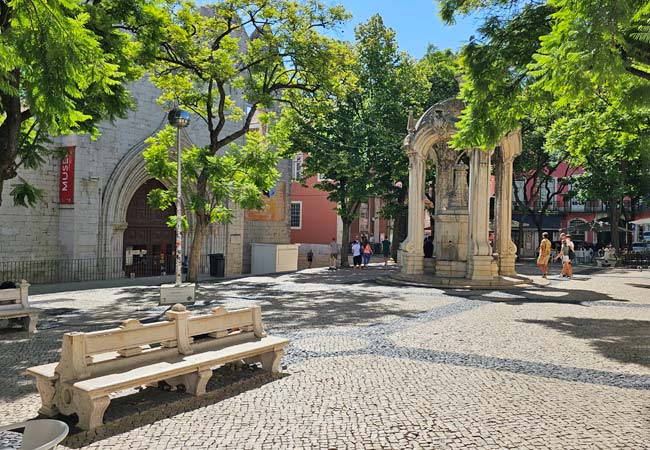
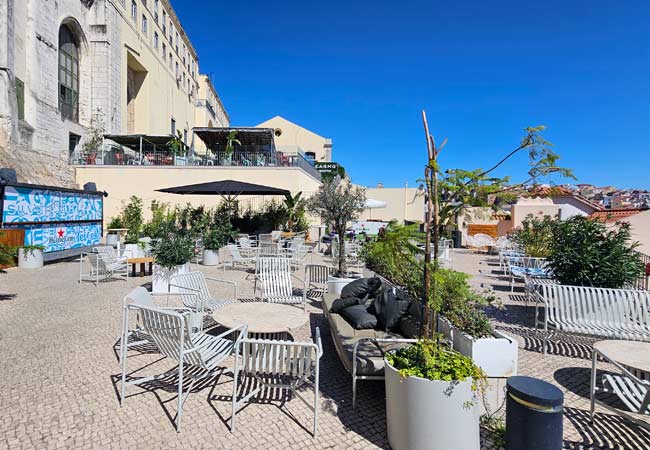
Carmo Rooftop is a trendy place for evening drinks
The Igreja do Carmo Church
Prior to the 1755 earthquake, the Igreja do Carmo was the largest and grandest of Lisbon’s many churches, with towering Gothic arches, magnificent stained-glass windows, and an extensive library of over 5,000 religious books.
Today, the haunting ruins remain as a reminder of the devasting earthquake that struck during the feast of All Saints (1st November) and killed hundreds packed in the church as the roof collapsed. It was decided never to rebuild the church, and so that it would be a permanent memorial to the tragic events that occurred during the earthquake.
To view the interior of the church, a ticket to the Museu Arqueológico do Carmo must be purchased.
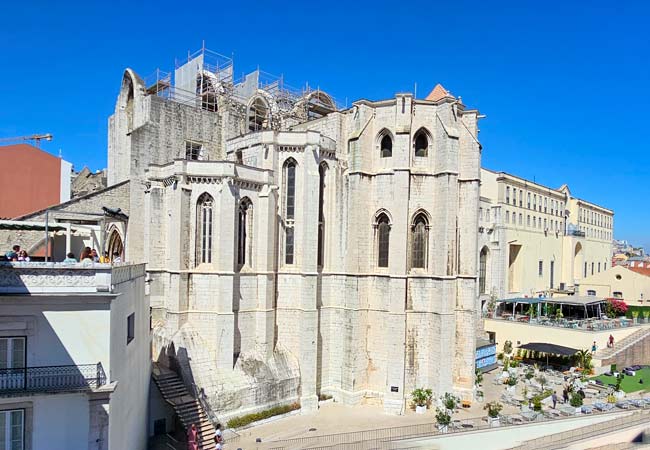
The eastern side of the Igreja do Carmo as seen from the Elevador de Santa Justa
Museu Arqueológico do Carmo
Museu Arqueologico do Carmo was Portugal’s first archaeology museum, and lies within the ruins of the Igreja do Carmo. The museum was set up to safeguard important artefacts after the expulsion of Religious Orders from Portugal in 1834.
The museum contains a number of unique artefacts and creepy mummies, but the real interest is to walk around the ruins of the Gothic church and the Chapel and Sacristy that survived the earthquake.
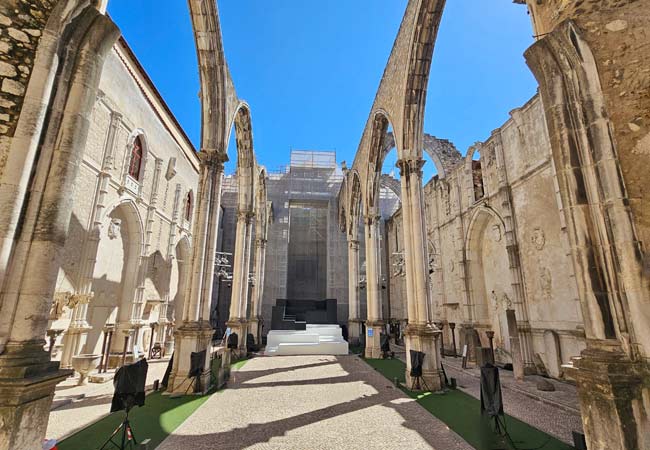
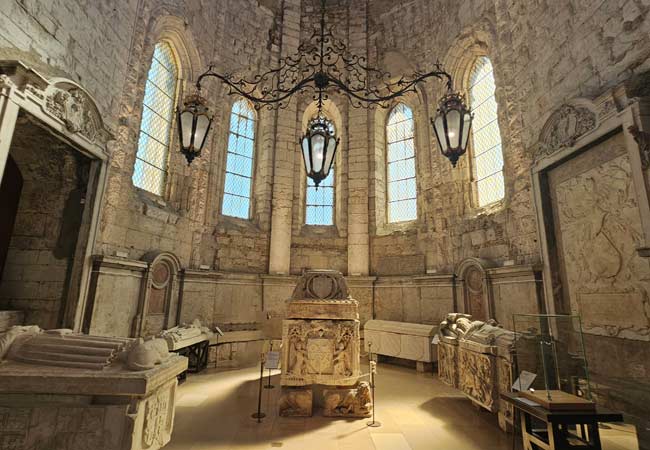
The tomb of King Ferdinand I in the chapel of the church
Museu da Guarda Nacional Republicana
Museu da Guarda Nacional Republicana is housed in the Comando Geral, the headquarters of the GNR police force. This small museum details the history of the GNR since its formation in 1911, and includes vehicles, uniforms and weapons.
The GNR building is important in Portuguese modern history as it was here that Marcelo Caetano, the leader of the Estado Novo, took refuge during the 1974 revolution and later declared the end regimen from the building’s balcony.
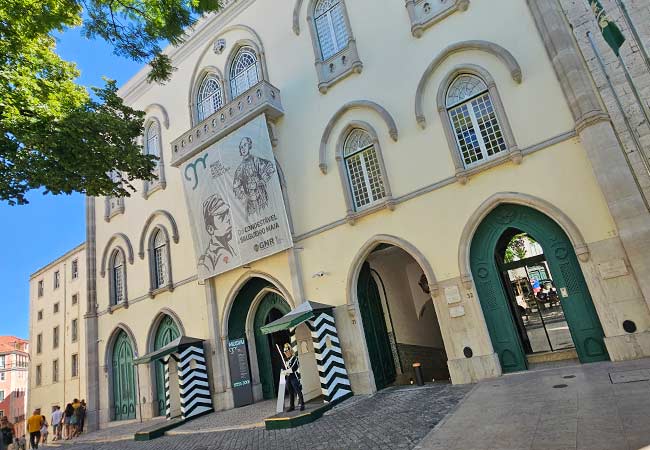
Igreja do Santíssimo Sacramento
A surprisingly beautiful church that dates from 1685 but was reconstructed after the 1755 earthquake. The church follows the typical Pompeian style found in many other 18th century churches, but it is unique for the stunning fresco painting that covers the entire ceiling.

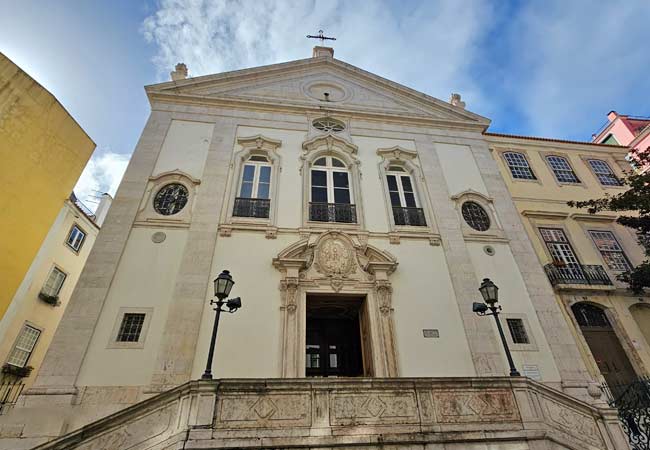
Palácio dos Condes de Valadares
The unassuming brown-red building on the southern corner of the Largo do Carmo is the former Palácio Valadares. This unfortunate building was destroyed by the 1755 earthquake and was subsequently burnt down in 1798 after its reconstruction.
Prior to being a palace, the site was the location of Portugal’s first university (established in 1290), before it was transferred to Coimbra in 1537.
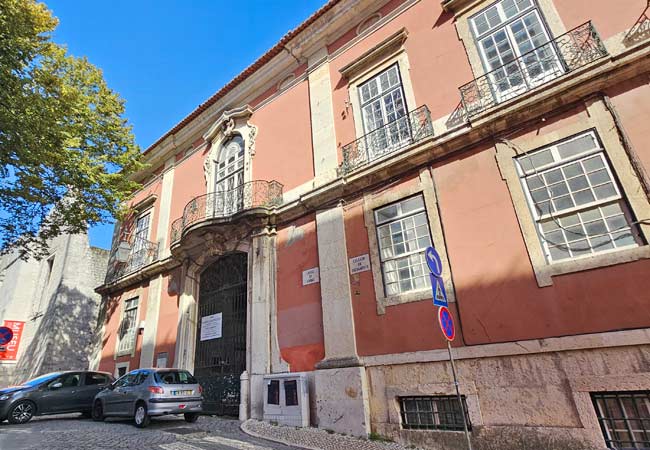
The History of the Elevador de Santa Justa
The Elevador de Santa Justa was designed by Raul Mesnier de Ponsard, a student of the great iron craftsman Gustave Eiffel, whose crowning glory was the magnificent Eiffel Tower. Ponsard, after studying under Eiffel, returned to his home city of Lisbon to design his iron masterpiece: the Elevador de Santa Justa.
Unlike the Eiffel Tower, the Elevador de Santa Justa actually solves a problem within Lisbon: how to ascend the steep hills in the heat of summer. The funding for the project was provided by the royal court, and construction began in 1900.
The Gothic superstructure and upper walkway were formally opened by King Carlos I in August 1901, but at this stage, the cabins and the steam engine had not been installed.
The official opening was on the 10th July 1902, after two days of rushed of testing. The actual opening day saw a freak storm with torrential rain and lightning, but still, more than 3,000 tickets were sold on the first day. By the end of the first year, more than half a million passengers had ridden in the lift, making it nearly as popular as Eiffel’s tower.
The original elevator was powered by a giant steam engine, but it was converted to a much safer and cleaner electrical motor in 1907, which still powers the lift today.
In 1973, the Elevador de Santa Justa came under public ownership and was amalgamated into the government-run Carris Corporation, which also manages the tram and bus network. In 2002, the Elevador de Santa Justa and the three remaining cable railways of Lavra, Glória and Bica, were classified as National Monuments.
Discover more of Lisbon with our most popular guides
If you've found our content valuable, we'd welcome your support.
The digital publishing landscape has evolved significantly. As a small independent publisher, we face growing challenges. Search engines increasingly favour paid content over organic results, while AI-generated content often reproduces original work without attribution.
To support our work, please consider bookmarking this page (press Ctrl + D) for quick access. If you find an article helpful, we'd be grateful if you'd share it with friends on social media.
For specific questions, please see our Reddit community at r/LisbonPortugalTravel.
Should you notice any outdated or incorrect information, please contact us at [email protected]
Thank you for helping us continue to provide valuable content in an increasingly challenging digital environment.
A complete list of all of our Lisbon articles
If you've found our content valuable, we'd welcome your support.
The digital publishing landscape has evolved significantly. As a small independent publisher, we face growing challenges. Search engines increasingly favour paid content over organic results, while AI-generated content often reproduces original work without attribution.
To support our work, please consider bookmarking this page (press Ctrl + D) for quick access. If you find an article helpful, we'd be grateful if you'd share it with friends on social media.
For specific questions, please see our Reddit community at r/LisbonPortugalTravel.
Should you notice any outdated or incorrect information, please contact us at [email protected]
Thank you for helping us continue to provide valuable content in an increasingly challenging digital environment.




































